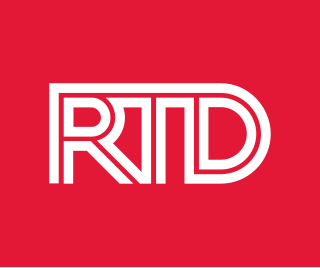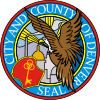
The Metro Blue Line is a 12-mile (19.3 km) light rail line in Hennepin County, Minnesota, that is part of the Metro network. It travels from downtown Minneapolis to Minneapolis–Saint Paul International Airport and the southern suburb of Bloomington. Formerly the Hiawatha Line prior to May 2013, the line was originally named after the Milwaukee Road's Hiawatha passenger train and Hiawatha Avenue, reusing infrastructure from the former and running parallel to the latter for a portion of the route. The line opened June 26, 2004, and was the first light rail service in Minnesota. An extension, Bottineau LRT, is planned to open in 2028.

Denver Union Station is the main railway station and central transportation hub in Denver, Colorado. It is located at 17th and Wynkoop Streets in the present-day LoDo district and includes the historic station house, a modern open-air train shed, a 22-gate underground bus station, and light rail station. A station was first opened on the site on June 1, 1881, but burned down in 1894. The current structure was erected in two stages, with an enlarged central portion completed in 1914.
FasTracks is a multibillion-dollar public transportation expansion plan under construction in metropolitan Denver, Colorado, United States. Developed by the Regional Transportation District (RTD), the plan consists of new commuter rail, light rail, and express bus services. Six new light rail, electric commuter rail and diesel commuter rail lines with a combined length of 122 miles (196 km) will be constructed under the plan. It expands on previous transportation projects, notably T-REX, and includes 57 new transit stations and stops, 21,000 new parking spaces, 18 miles (29 km) of a bus service between Denver and Boulder and the renovation of Denver Union Station as a multi-modal transportation hub.

The Regional Transportation District, more commonly referred to as RTD, is the regional agency operating public transit services in eight out of the twelve counties in the Denver-Aurora-Boulder Combined Statistical Area in the U.S. state of Colorado. It operates over a 2,342-square-mile (6,070 km2) area, serving 3.08 million people. RTD was organized in 1969 and is governed by a 15-member, publicly elected Board of Directors. Directors are elected to a four-year term and represent a specific district of about 180,000 constituents.

The Alvarado Transportation Center (ATC) is a multimodal transit hub located at 100 1st Street SW in Downtown Albuquerque, New Mexico. The complex was built as a hub for Albuquerque's regional transit system and as a replacement for Albuquerque's previous bus depot and train station. The center serves ABQ RIDE, Amtrak, Greyhound Lines, and the New Mexico Rail Runner Express commuter rail line.

The DC Circulator is a bus system in Washington, D.C. The District of Columbia Department of Transportation operates the service in a public–private partnership with RATP Dev.

The El Monte Busway is a 12-mile (19 km) shared-use express bus corridor (busway) and high occupancy toll (HOT) lanes running along Interstate 10 between Union Station in Downtown Los Angeles and Interstate 605 or El Monte Station in El Monte, California. Buses also make intermediate stops at Cal State LA station and LA General Medical Center station. The busway opened in January 1973 to buses only, three-person carpools were allowed to enter in 1976, and the facility was converted to HOT lanes as part of the Metro ExpressLanes project on February 22, 2013.

Five Points is a metro station of the Metropolitan Atlanta Rapid Transit Authority (MARTA) rail system in Atlanta, Georgia. It is the transfer point for all rail lines and serves as the main transportation hub for MARTA. It provides access to the Five Points Business District, Georgia State University, Underground Atlanta, City Hall, the Richard B. Russell Federal Building, CobbLinc, Ride Gwinnett, GRTA Xpress Transit, Station Soccer, and the tourism heart of Downtown Atlanta. It provides connecting bus service to Zoo Atlanta, Grant Park, Atlanta University Center, East Atlanta Village, Martin Luther King Jr. National Historical Park, Carter Center, Atlanta City Hall, South Dekalb Mall and Fulton County Government Center.

Littleton–Downtown station is a RTD light rail station in Littleton, Colorado, United States. Operation as a light rail station began on July 14, 2000, with both bus and light rail run by the Regional Transportation District. The station initially saw service on the C Line and D Line, however C Line service ended in 2021. Today the station is only served by the D Line.

Harbor Gateway Transit Center, formerly Artesia Transit Center, is a large bus station at the southern end of the Harbor Transitway that serves as a transport hub for the South Bay region of Los Angeles County including the Harbor Gateway neighborhood of Los Angeles and cities of Carson, Gardena, and Torrance. The station consists of one large island platform with 12 bus bays and a 980 space park and ride parking lot located in the southwest corner of Interstate 110 and California State Route 91.
Environmental Performance Vehicles (EPV), previously DesignLine Corporation, is a manufacturer of coach, electric and range-extended electric (hybrid) buses. It was founded in Ashburton, New Zealand in 1985. Initially it was a manufacturer of tour coaches. In the 1990s it diversified into conventional transit buses and then added hybrid city buses in the late 1990s. It was acquired by American interests in 2006, and DesignLine Corporation's headquarters was relocated to Charlotte, North Carolina. Following a bankruptcy in 2013, the assets of DesignLine were sold and the company was renamed.

The A Line is a Regional Transportation District (RTD) commuter rail line serving Denver and Aurora, Colorado, operating between downtown Denver and Denver International Airport (DIA). During planning and construction, it was also known as the East Rail Line, but most locals refer to it as the A Line. Despite its former title, the line does not serve the campuses of the University of Colorado.

Flatiron Flyer is an 18-mile (29 km) express bus system between Denver, Aurora, and Boulder, Colorado, traveling along U.S. Route 36. Different levels of service are available, including a non-stop from Boulder to Union Station in high-occupancy toll lanes, and all-stop, which serves six park-and-rides along U.S. Route 36 in normal highway lanes. The line branches out to different destinations in Denver, Aurora and Boulder. The Regional Transportation District operates the line, opened on January 3, 2016.

38th & Blake station is a Regional Transportation District (RTD) commuter rail station on the A Line in the Five Points neighborhood of Denver, Colorado. The station is the first station eastbound from Union Station in Downtown Denver and sixth westbound from Denver International Airport. Travel times are about four minutes from Union Station and 33 minutes from Denver Airport.

16th & California and 16th & Stout stations are a pair of is an light rail stations in Downtown Denver, Colorado, United States. It is served by the D, H, and L lines, operated by the Regional Transportation District (RTD), and was opened on October 8, 1994. These stations have one track each, and are one city block apart. 16th & California is served only by northbound trains and 16th & Stout is served only by southbound trains. These stations serve the 16th Street Mall and provide connections to the MallRide shuttle bus and Union Station via the shuttles.

40th & Colorado station is a Regional Transportation District (RTD) commuter rail station on the A Line in the Elyria-Swansea neighborhood and adjacent to the Park Hill neighborhood of Denver, Colorado. The station is the second eastbound station from Union Station in Downtown Denver and fifth westbound from Denver International Airport. About nine minutes from Union Station and 28 minutes from Denver Airport station.

Peoria station, also known as Peoria/Smith station, is a Regional Transportation District (RTD) station in Aurora, Colorado. The station is served by the A Line, a commuter rail line from Union Station in Downtown Denver to Denver International Airport, and the R Line, a light rail line crossing through Aurora and South to Lone Tree. A Line travel times from the station to Downtown Denver and Denver International Airport are about 17 and 20 minutes, respectively. Peoria station is the northern terminus of the R Line with a travel time of 58 minutes to the southern terminus at Lincoln station.

The BYD K10MR is a battery-electric transit bus built by BYD Auto, exclusively for the RTD MallRide shuttle in Denver.





















